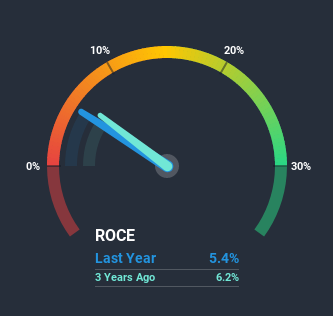
To find a multi-bagger stock, what are the underlying trends we should look for in a business? In a perfect world, we'd like to see a company investing more capital into its business and ideally the returns earned from that capital are also increasing. This shows us that it's a compounding machine, able to continually reinvest its earnings back into the business and generate higher returns. Although, when we looked at Lindsay Australia (ASX:LAU), it didn't seem to tick all of these boxes.
What is Return On Capital Employed (ROCE)?
If you haven't worked with ROCE before, it measures the 'return' (pre-tax profit) a company generates from capital employed in its business. Analysts use this formula to calculate it for Lindsay Australia:
Return on Capital Employed = Earnings Before Interest and Tax (EBIT) ÷ (Total Assets - Current Liabilities)
0.054 = AU$15m ÷ (AU$372m - AU$91m) (Based on the trailing twelve months to December 2020).
Therefore, Lindsay Australia has an ROCE of 5.4%. In absolute terms, that's a low return and it also under-performs the Transportation industry average of 7.1%.
View our latest analysis for Lindsay Australia

Above you can see how the current ROCE for Lindsay Australia compares to its prior returns on capital, but there's only so much you can tell from the past. If you'd like, you can check out the forecasts from the analysts covering Lindsay Australia here for free.
What The Trend Of ROCE Can Tell Us
In terms of Lindsay Australia's historical ROCE movements, the trend isn't fantastic. Around five years ago the returns on capital were 7.4%, but since then they've fallen to 5.4%. On the other hand, the company has been employing more capital without a corresponding improvement in sales in the last year, which could suggest these investments are longer term plays. It's worth keeping an eye on the company's earnings from here on to see if these investments do end up contributing to the bottom line.
The Bottom Line
To conclude, we've found that Lindsay Australia is reinvesting in the business, but returns have been falling. And investors may be recognizing these trends since the stock has only returned a total of 0.2% to shareholders over the last five years. Therefore, if you're looking for a multi-bagger, we'd propose looking at other options.
One more thing to note, we've identified 4 warning signs with Lindsay Australia and understanding them should be part of your investment process.
While Lindsay Australia may not currently earn the highest returns, we've compiled a list of companies that currently earn more than 25% return on equity. Check out this free list here.
If you decide to trade Lindsay Australia, use the lowest-cost* platform that is rated #1 Overall by Barron’s, Interactive Brokers. Trade stocks, options, futures, forex, bonds and funds on 135 markets, all from a single integrated account. Promoted
If you're looking to trade Lindsay Australia, open an account with the lowest-cost platform trusted by professionals, Interactive Brokers.
With clients in over 200 countries and territories, and access to 160 markets, IBKR lets you trade stocks, options, futures, forex, bonds and funds from a single integrated account.
Enjoy no hidden fees, no account minimums, and FX conversion rates as low as 0.03%, far better than what most brokers offer.
Sponsored ContentNew: AI Stock Screener & Alerts
Our new AI Stock Screener scans the market every day to uncover opportunities.
• Dividend Powerhouses (3%+ Yield)
• Undervalued Small Caps with Insider Buying
• High growth Tech and AI Companies
Or build your own from over 50 metrics.
This article by Simply Wall St is general in nature. It does not constitute a recommendation to buy or sell any stock, and does not take account of your objectives, or your financial situation. We aim to bring you long-term focused analysis driven by fundamental data. Note that our analysis may not factor in the latest price-sensitive company announcements or qualitative material. Simply Wall St has no position in any stocks mentioned.
*Interactive Brokers Rated Lowest Cost Broker by StockBrokers.com Annual Online Review 2020
Have feedback on this article? Concerned about the content? Get in touch with us directly. Alternatively, email editorial-team (at) simplywallst.com.
About ASX:LAU
Lindsay Australia
Provides integrated transport, logistics, and rural supply services to the food processing, food services, fresh produce, and horticulture sectors in Australia.
Established dividend payer and good value.
Market Insights
Community Narratives



